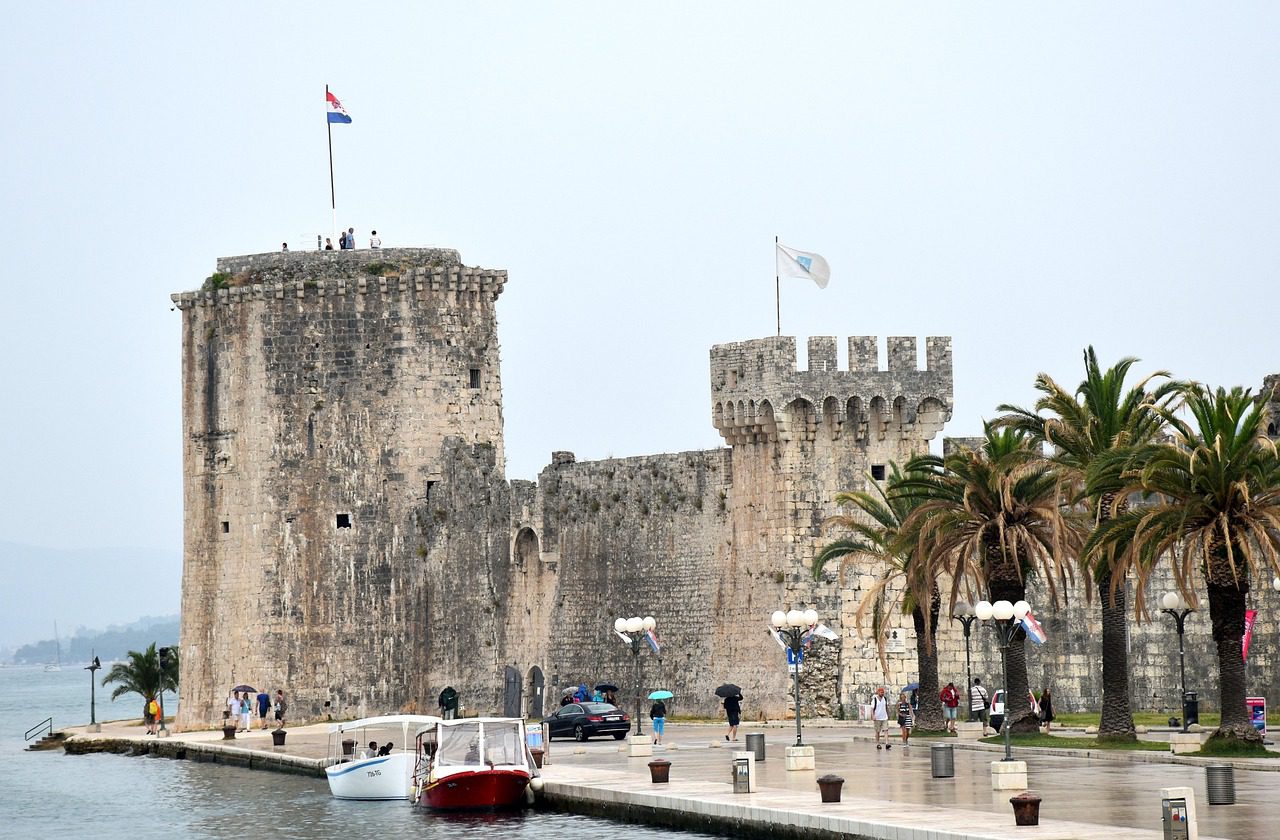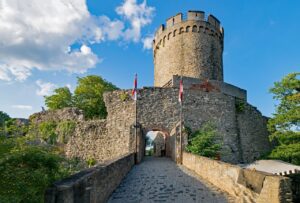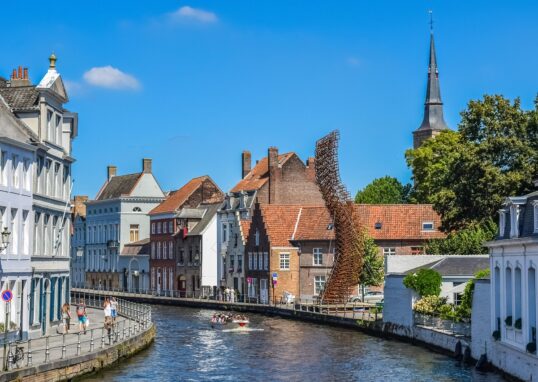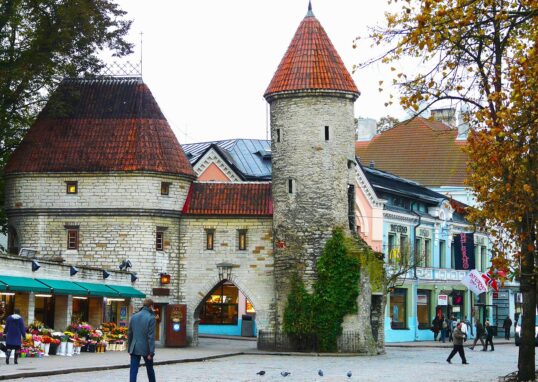
Castles of Europe – A Journey Through Time
Europe is a land of tales, myths, and magnificent structures. Among them, one of the most striking wonders is its castles. Over mountains, valleys, rivers, and shores, European castles rise proudly to remind one of royal strength, medieval combats, and architectural genius. These castles were not only homes to kings and queens but also fortresses for protection, thus having the role of centers of power. Many of them have survived wars and centuries of weather, and today they attract millions of visitors from around the world.
Let’s take a closer look at some of the most famous castles in Europe, their history, and architecture, along with some beautiful places that surround them. 
Neuschwanstein Castle, Germany
Neuschwanstein Castle is one of the most beautiful and famous castles in the world, located in Bavaria, Germany. The building of the castle took place during the 19th century by order of King Ludwig II of Bavaria. He wanted to have a fairy-tale castle, inspired by German legends and operas. It sits at the top of a hill just outside the village of Hohenschwangau. In appearance, it looks almost fairy-tale-like with high white towers and blue roofs. The castle was never fully completed because the king died before completing it. Inside are rooms lined with paintings and sculptures from Wagner’s operas, while the Throne Room, Singer’s Hall, and royal chambers are particularly spectacular. Walt Disney drew his inspiration for Sleeping Beauty Castle from Neuschwanstein Castle.
The castle is situated among mountains, forests, and lakes. The Alpsee Lake nearby mirrors the castle exquisitely. Visitors can also visit Hohenschwangau Castle, where King Ludwig II grew up. A small town called Füssen isn’t very far away, with its old narrow streets, restaurants, and shops to behold and wander around.
Windsor Castle, England
Windsor Castle is one of the oldest and largest inhabited castles in the world, with its location being Berkshire, England. The castle was originally built in the 11th century by William the Conqueror. It has been the home of British monarchs for over 900 years. History and royal tradition come together in this castle. There is much beauty in the towers, courtyards, and famous Round Tower that comprise the castle. One of the best examples of Gothic architecture in England is St. George’s Chapel, inside the castle grounds; many royal weddings and burials take place there. Visitors can view the State Apartments, the Queen Mary’s Dolls’ House, and the royal gardens. The Ceremony of Changing the Guard is a very popular attraction.
The town of Windsor is charming, with cobbled streets and local shops. It has the River Thames nearby, with lovely boat trips. On the other side of the river is Eton College, one of the oldest schools in England. The Windsor Great Park, filled with ancient oak trees and deer, is perfect for walking.
Château de Chambord, France
Château de Chambord is a masterpiece of Renaissance architecture. It is located in the Loire Valley of France. The castle was built in the 16th century for King Francis I as a hunting lodge. Its design is said to have been inspired by Leonardo da Vinci, who lived in France at the time. It contains 440 rooms, 84 staircases, and more than 300 fireplaces. The double helix staircase at the core of the building is one of its most famous features. This castle stands in the middle of a large forest and has a moat. The castle is not only beautiful but also full of history and mystery.
The Loire Valley is a region commonly referred to as the “Garden of France” because of its vineyards, gardens, and charming towns. Nearby castles include Chenonceau and Blois. Cycling, wine tastings, and river cruises abound in this area.
Edinburgh Castle, Scotland
Edinburgh Castle is one of Scotland’s most recognizable features. It proudly sits atop Castle Rock, overlooking the city of Edinburgh. The castle has a long and dramatic history. It was once both a royal residence and a formidable military fortress. Inside the castle, visitors can see the Crown Jewels of Scotland and the Stone of Destiny. The Great Hall and St. Margaret’s Chapel are other sites that should not be missed. Every year, the Edinburgh Military Tattoo happens here; it draws both performers and visitors from different parts of the globe.
The Royal Mile sits beneath the castle, lined with shops, pubs, and museums. The Old Town of Edinburgh surrounds it, full of medieval charm. There is an ancient volcano called Arthur’s Seat quite nearby that offers great views of the city.
Prague Castle, Czech Republic
Prague Castle is the largest ancient castle complex in the world and covers an area of almost 70,000 square meters. It has been the seat of Czech kings, emperors, and presidents. The Castle complex comprises palaces, churches, gardens, and towers. The crowning glory is the Gothic St. Vitus Cathedral, with its tall spires and vibrant stained glass. Golden Lane, lined with small, colored houses, reveals what life was like for castle workers. The castle stands upon a hill overlooking the Vltava River and the Old Town of Prague.
This city is full of beauty: the Charles Bridge, the Old Town Square, and the Astronomical Clock are just close. From the castle, it is possible to see red roofs and a winding river, creating a fairy-tale view.
Pena Palace, Portugal
Palacio de Pena is located in Sintra close to Lisbon; it is one of the most colorful and unusual castles in Europe, built upon the ruins of an old monastery in the 19th century. Its design includes both Gothic, Renaissance, and Moorish styles. Its bright red, yellow, and purple walls make it look like something from a dream. Inside, the rooms are richly decorated with royal furniture and paintings. The palace is surrounded by Pena Park, full of exotic trees and flowers.
The town of Sintra is a UNESCO World Heritage Site, hosting other stunning attractions like the Moorish Castle, Quinta da Regaleira, and Monserrate Palace, among others. The Sintra mountains and the coastline to the Atlantic nearby make this area a paradise for nature lovers.
Bran Castle, Romania
Bran Castle is often called Dracula’s Castle, although there is little evidence to connect it with the real Vlad the Impaler; it sits high on a cliff in the Carpathian Mountains of Transylvania. The castle has a medieval look with tall towers, narrow stairs, and hidden passages. Now it is a museum that exhibits royal history and legends. Visitors come here not only for the architecture but also for the mysterious atmosphere. It is a mix of legend and history that comes together to form one of the most visited sites in Romania.
The small town of Bran has local markets where crafts and foods are sold. Not far away is the beautiful city of Brașov: a place with medieval streets and churches. The Carpathian Mountains offer hiking trails, ski resorts, and breathtaking views.
Alcázar of Segovia, Spain
The Alcázar of Segovia is one of the most beautiful castles in Spain, with its pointed towers, just like a palace out of a fairytale. The castle was originally a fortress, later used as both a royal residence and a military academy. Its location on a rocky hillside gives it a commanding view over the city and rivers below. Internally, the Hall of Kings and the Throne Room are examples of Moorish and Gothic design.
Segovia features an incredible Roman aqueduct, one of the most well-preserved in Europe. Its old town is full of stone streets, cathedrals, and traditional restaurants with cochinillo asado-a dish comprising roast suckling pig.
Buda Castle, Hungary
The beautiful Buda Castle sits atop a hill overlooking the Danube River, in Budapest. First built in the 13th century, it was rebuilt in the Baroque style. The castle complex includes the Hungarian National Gallery, the Budapest History Museum, and the National Library. The castle shines bright with lights into the night, creating this magical reflection in the river.
On the opposite side of the river stands one of the most photographed buildings in Europe: the Parliament Building. The Chain Bridge links Buda with Pest, while the nearby Fisherman’s Bastion offers views across the city.
Mont Saint-Michel, France
Mont Saint-Michel is an abbey with a castle-like appearance rising out of the sea on a small island in Normandy. It was built in the 8th century and eventually became one of France’s most iconic landmarks. With the high tide, the island is entirely surrounded by water. The abbey, narrow streets, and small houses create a magical scene. Within the abbey, visitors can see the Gothic halls, chapels, and beautiful cloisters.
The nearby Normandy coast has long beaches and a selection of seafood restaurants. Visitors often stay in nearby towns like Pontorson or Avranches. The view of the sunset over Mont Saint-Michel is stunning.
Surrounding Places and Castle Trails
Europe’s castles are not just ancient strongholds or royal residences but form part of scenic landscapes, historic towns, and natural wonders. Many castles stand amidst mountains, rivers, forests, and quaint villages that make them all the more enchanting.
The Romantic Road – Bavaria, Germany
The Romantic Road is one of the most beautiful travel routes in Europe, running for about 400 kilometers from Würzburg to Füssen in southern Germany. Along this route, the travelers find quaint medieval towns, vineyards, and fairy-tale castles. This dreamlike fairytale castle of Neuschwanstein is the highlight of the route. It stands near the village of Hohenschwangau, at the foot of the Bavarian Alps and clear mountain lakes. Travelers can also visit Rothenburg ob der Tauber, which is a perfectly preserved medieval town with stone walls, cobbled streets, and half-timbered houses. The Romantic Road is not just about castles; it’s about a drive through history, music, and scenic beauty.
The Loire Valley – France
The Loire Valley, often referred to as the “Garden of France,” is noted for its beautiful Renaissance châteaux. Situated on the river with the same name in central France, the area is speckled with emerald vineyards, flower gardens, and quaint villages. Around these castles are charming towns, such as Amboise, where Leonardo da Vinci spent his final years, and Tours, a city famous for its art and food. Visitors can taste local wines, especially Sauvignon Blanc, and French pastries in small cafes. One of the best ways to explore the region is cycling along the Loire à Vélo trail. The entire area feels like one big open-air museum, combining nature with architecture and fine living.
The Scottish Highlands – Scotland
The Scottish Highlands feature some of Europe’s most dramatic landscapes and castles. History and nature go in perfect harmony here. Perhaps the most famous is Eilean Donan Castle, which stands on a tiny island where three lochs meet; it’s one of the most photographed castles anywhere in the world because of its reflection in the water. Further north, Urquhart Castle looks over Loch Ness-the famous location associated with the legend of the Loch Ness Monster. The ruins of the castle bear tales of medieval battles and royal struggles.
Transylvanian Castle Trail – Romania
Romania’s Transylvanian Castle Trail is full of mystery, legends, and medieval charm. The most famous sight in this area is Bran Castle, but it is popularly known as “Dracula’s Castle.” It stands high on a cliff surrounded by pine forests and the Carpathian Mountains. Close by is the Peleș Castle in Sinaia, one of the most beautiful castles in Europe, remarkably marrying the Gothic and Renaissance styles, full of fine art and woodwork. The Corvin Castle in Hunedoara could have been taken from a storybook with its tall towers and stone bridge. Other towns around, such as Brașov and Sibiu, feature cobblestoned streets, colored houses, and medieval walls. They arrange festivals, markets, and events with local music, which give life to the old atmosphere.
Sintra Castle Route – Portugal
Not far from Lisbon is the magical town of Sintra, a UNESCO World Heritage Site full of palaces and castles. The most colorful of them all, Pena Palace stands high on a hill with red, yellow, and purple walls. The nearby Moorish Castle provides panoramic views over the Atlantic Ocean.
The Danube Castle Route – Central Europe
The Danube River courses its way through many European countries: Germany, Austria, Slovakia, Hungary, and more. On its flanks stand numerous castles and palaces that once guarded the trade routes and royal lands. Among the major attractions, there’s a visit to Melk Abbey-an impressive baroque monastery that commands a perch on the river. Aggstein Castle is perched high on a cliff overlooking the Wachau Valley. In Hungary, the Buda Castle overlooks the Danube at Budapest. On the other side of the Danube is the beautiful Parliament Building and the Chain Bridge, which give the city an irresistible glow at night.
Rhine Castle Trail – Germany
On the Rhine River in Germany stands one of Europe’s most romantic castle routes, castles rising above the riverbanks around every bend between the cities of Koblenz and Bingen. It also shows one of the best-preserved medieval castles, Marksburg Castle; panoramic views, including those from Rheinstein Castle and Stolzenfels Castle; and its fairytale settings. The small towns lining the banks, such as Bacharach and Rüdesheim, are full of half-timbered houses, wine taverns, and local festivals. Rhine river cruises afford the visitor views of numerous castles in one day, with wine tastings and scenery.
The Alpine Castles Route – Austria and Switzerland
The Alpine Castle Route travels through Austria and Switzerland, combining majestic peaks with elegant fortresses. The Hohenwerfen Castle in Austria enjoys a commanding view over the Salzach Valley and presents a very medieval experience, complete with falconry displays. The nearby Hohensalzburg Fortress in Salzburg provides a stunning panorama of the old city and the Alps. Chillon Castle in Switzerland overlooks Lake Geneva, bordered by the Alps. Poets such as Lord Byron have been inspired by its dungeons, halls, and towers.
Iberian Castle Trail – Spain and Portugal
The Iberian Peninsula is one of Europe’s oldest and most dramatic fortresses. In Spain, the Alhambra of Granada stands as a stunning work of Moorish architecture, while gardens and mountains form a mysterious setting. The Alcázar of Segovia, due to its fairy-tale shape, inspired Disney’s castle design. Among the places to visit in Portugal are the Guimarães Castle, considered the birthplace of the nation, and the seaside Castle of Óbidos, which hosts medieval fairs.
The Nordic Castle Route – Northern Europe
In Denmark, Kronborg Castle in Helsingør inspired Shakespeare’s Hamlet, while in Sweden, Gripsholm Castle sits beside Lake Mälaren full of royal portraits and history. Turku Castle in Finland and Akershus Fortress in Norway represent northern strength and simplicity in medieval defense. These castles are surrounded by forests, lakes, and coastal towns that feel peaceful and refreshing. Among other experiences awaiting travelers are Nordic design, seafood, and long summer days.
Conclusion
Not only are Europe’s castles more than old buildings, but they are alive with history, culture, and imagination. Each of them has a unique story to tell about kings and queens, battles and dreams. From the fairy-tale towers of Neuschwanstein to the Gothic strength of Edinburgh, something is special about every castle. Nestled within mountains, rivers, forests, and enchanting towns, it is these castles that continue to stir the souls of travelers, reminding them of Europe’s rich past and its timeless beauty. Whether one walks down the hallways of a palatial house or up to the ramparts of a ruined fort, history reverberates all around. For Europe, its castles are not just monuments but the heart of its heritage.






